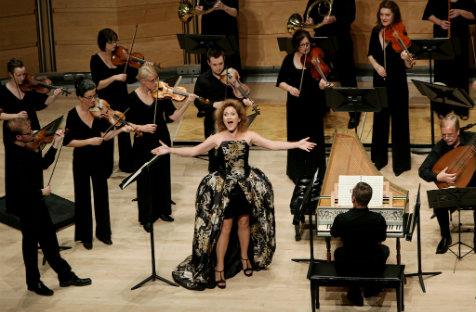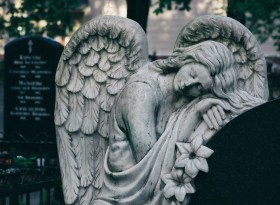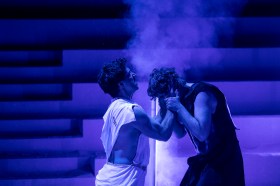Premieres are tricky beasts, I find. There are two types of premieres in the musical world: premieres of modern works, and premieres of old works. For the modern, there’s the excitement of the new, of the exposure to the language of the current century. For the old? It’s just more of the same stuff you’ve heard already, basically. And this is precisely where the trickiness lies in older works. Australia, it must be said, rarely ever gets world premieres of works from the 17th or 18th century – as you can imagine, most other countries have got there first – but we do, obviously, get a lot of Australian premieres (funny, that); and the fact that a work is an Australian premiere is never not mentioned by the relevant conductor or MC for the night. Take Paul Dyer, for instance – Artistic Director and conductor of the Australian Brandenburg Orchestra – who proudly proclaimed to the audience at the City Recital Hall that all but one of the pieces to be heard that evening were Australian premieres.
Constant cynic that this critic is – one is hardwired not to be amused too easily – I was unconvinced, and I did not, as some members of the audience did, whisper excitedly. No. It seems a little ridiculous to be excited about hearing something – something perfectly available (not suddenly unearthed) for the last however many hundreds of years – for the first time in a country. One always has the feeling that perhaps there was a reason why these pieces haven’t been heard in Australia before. Thankfully, soprano extraordinaire Simone Kermes (talked up by Dyer as one of the best sopranos in the world today, and also the selector of tonight’s program) managed to find a selection of arias and overtures fit for enthusiasm.
Kermes, it should be noted, is a bit more of a personality than a lot of other sopranos on the classical circuit. Her first entrance, for instance, was in a gold and black dress. (I now, as a man, apologise for the horrendous and technically starved description of the dress that will follow.) It was a wide dress at the hips (or waist), jutting out on each side to such an extent that would precipitate a woman walking sideways through a narrow door. Yet, in a modern twist, instead of reaching down to the feet on both the back and the front, it rather zoomed up at the front to reveal a near mini-skirt underneath, legs bare and heels prominent. If this doesn’t give you, dear reader, an idea of Kermes’ on stage persona, then nothing will.
We began with Porpora’s Overture to Agrippina, which was an energetic and short affair that continued onto his aria from Mitridate, ‘Vedra turbato il mare’. Vivaldi’s Violin Concerto in C Major RV 190 came next, with usual concertmaster of the ABO Matt Bruce as soloist – engaging enough, but nothing spectacular. Porpora and Kermes re-entered, and we heard ’Alto Giove’ from Polifemo and ’Empi, se mai disciolgo’ from Germanico in Germanica. While the verbal acrobatics of Kermes were both a sight and noise to behold – she is quite the physically expressive and dominant performer, too – it was the slow ‘Alto Giove’ that stood out for its unimpeded beauty and lushness of tone.
After the interval came Leo’s aria ’Son qual nave’ from Zenobia in Palmira, then Albinoni’s Sinfonia in G minor, then Pergolesi’s aria ’Sul mio cor’ from Adriano in Siria followed by the overture of the same opera, and the program finished with another aria from Germanico in Germanica, ‘Se dopo ria procella’.
Three encores followed, the third being a request from some German members of the audience who were mad for something from Griselda (heard – possibly in an Australian premiere – with Pinchgut Opera two years ago). Kermes, German herself, conversed in their native language for a bit with them. Another was an arrangement of a German anti-war song which was banned by Hitler, and the other was one written by Riccardo, brother of the highly celebrated castrato, Farinelli.
Dyer, anticipating the overwhelming response from the audience (and it certainly was – after the first aria of the evening, the audience erupted with cheers and applause) had brought along some numbered cards, to indicate which encore we were up to next. This was a highly engaging concert, with a bundle of fun for a soprano, and one not to be missed.
Rating: 4 ½ stars out of 5
Fearless Baroque
Australian Brandenburg Orchestra
Paul Dyer (artistic director and harpsichord), Simone Kermes (soprano), Matt Bruce (violin)
Porpora – Overture to Agrippina
Porpora – Aria ‘Vedra turbato il mare’ from Mitridate
Vivaldi – Violin Concerto in C Major RV 190
Porpora – Aria ‘Alto Giove’ from Polifemo
Porpora -Aria ‘Empi, se mai disciolgo’ from Germanico in Germania
Leo – Aria ‘Son qual nave’ from Zenobia in Palmira
Albinoni – Sinfonia in g minor
Pergolesi – Aria ‘Sul mio cor’ from Adriano in Siria
Pergolesi – Overture to Adriano in Siria
Porpora – Aria ‘Se doppo ria procella’ from Germanico in Germania
City Recital Hall, Sydney
4 September






